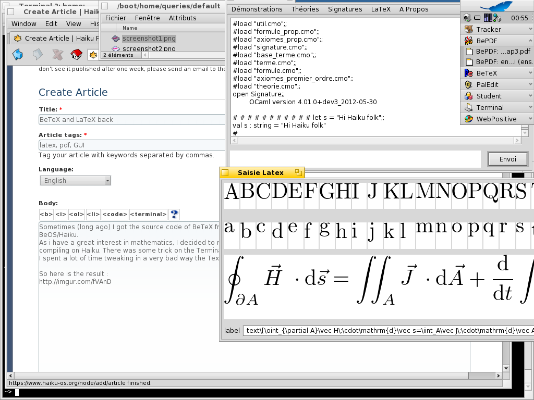So here is the result :

More precise mathematical formulas (note antialiasing and italic/roman mathematical characters):
 (a little easter egg : ocaml toplevel in a window)
(a little easter egg : ocaml toplevel in a window)
As soon as i can do a package i will post it on haikuware, with instructions for latex installation.
UPDATE :
See my last comment : the zip is ready but not available yet on the internet ; Instructions for installation will follow those of TeXLive with custom binaries (see the comment for details).
The recommended method for building Haiku on Mac OS X is to use MacPorts, but, with a little bit of work it is possible to build Haiku using homebrew on Mac OS X 10.6 or 10.7 instead. You’ll need to install Xcode or at least the Command Line Tools before installing homebrew.
If you don’t want to install all of XCode you can install just gcc from the packages available here:
Five students to be mentored by Haiku in Google Summer of Code 2012!

For this year's Google Summer of Code™ program, we at Haiku have been allocated five students!
In 2012, 406 mentoring organizatins applied and 4258 students submitted 6685 proposals.
Haiku is proud to be one of the 180 accepted mentoring organizations,
with five accepted students.
Over the years, Haiku's goals for Google Summer of Code have evolved.
Originally the ability to evaluate the students' capabilities was lacking and the attention was simply on choosing projects that filled a need.
Now, the emphasis is placed on choosing the best students, as they are more important than their short term code contributions.
During the application process, those students instilled a sense of hope and confidence in Haiku's mentors that they will mature into full project contributors.
In other words, this is our opportunity to grow and refine young, intelligent, and highly motivated
students into people who will continue to develop Haiku in the years to come.
For the past three years, students applying to Haiku were (at first encouraged and later) required to submit a code contribution.
By requiring potential students to submit a code contribution during the application period, Haiku's mentors achieve several things.
First and foremost, it shows that each student possesses basic skills that many of us take for granted -- using a bug tracker and compiling Haiku's sources.
More importantly, it provides our mentors with some insight into each individual student's motivation and abilities.
This year a total of 17 patches
were submitted during the application period. 13 of which were submitted by our top 5 selected students!
Qualifying students can apply for a Haiku project (see the list of suggested projects below) between March 26th and April 6th, 2012. For details about how to apply, please check out Students: How to Apply for a Haiku Idea.
According to other mentor organizations, the most successful Google Summer of Code projects are the ones proposed by the students themselves. The following list represents our ideas and wishes of our project. However, suggesting your own idea is encouraged!
This year, 5 students participated into GSoC and all completed their projects
The very first thing you need to do is install Doxygen and git onto your system if you haven’t already done that. The best version of Doxygen to use is 1.7.3 since that is what is used on the server to automatically build the documentation, but, the latest one should work fine.
Next grab the Haiku source from git by running: git clone git://git.haiku-os.org/haiku in the directory you wish to work (note it will automatically create a haiku/ sub-directory for you.)
This article will describe current state of Haiku bootstrap architecture. It will unveil information about earliest boot stages, some hints to platform porters will be given. This can be interpreted as an extension to Haiku Article How to get Haiku booted.

Haiku’s source code is currently being hosted on a
Git-based repository using Gerrit.
If you are already familiar with the pull request workflow as used, for example, on GitHub, you
can find an overview of the differences in Gerrit user’s manual.
Anonymous access will allow anyone to download Haiku’s source code; However,
the authenticated (non-anonymous) method is required for submitting patches.
Eight students to be mentored by Haiku in Google Summer of Code 2011!

For this year's Google Summer of Code™ program, we at Haiku have been allocated eight students!
In 2011, 417 mentoring organizations applied and 3731 students submitted 5474 proposals.
Haiku is proud to be one of the 175 accepted mentoring organizations, with 35 submitted proposals and 8 accepted students.
Over the years, Haiku's goals for Google Summer of Code have evolved.
Originally the ability to evaluate the students' capabilities was lacking and the attention was simply on choosing projects that filled a need.
Now, the emphasis is placed on choosing the best students, as they are more important than their short term code contributions.
During the application process, those students instilled a sense of hope and confidence in Haiku's mentors that they will mature into full project contributors.
In other words, this is our opportunity to grow and refine young, intelligent, and highly motivated
students into people who will continue to develop Haiku in the years to come.
As with many other FOSS mailing lists, we at Haiku hold ourselves to a few rules when posting to mailing lists. For now most of these are to ensure that all information is properly archived or to improve a message's readability. In the future this list may be expanded with additional detail.
Message Body
No Top Posting
Top posting refers to clicking "reply", leaving all the text intact, and inserting your text at the top of the message body. Doing so removes the context of what you are replying to. This makes it more time consuming and difficult for everyone else as it may require them to re-read that email a few times before fully understanding the message.
